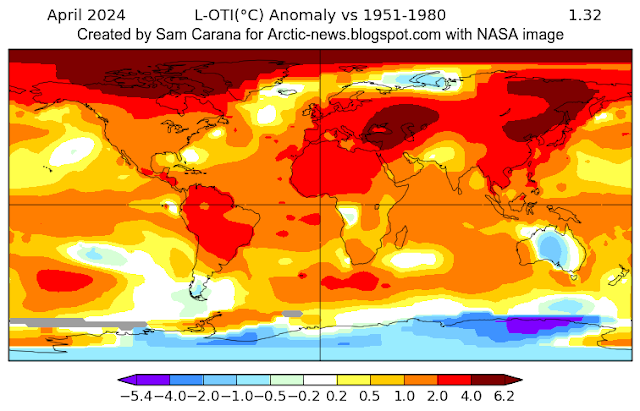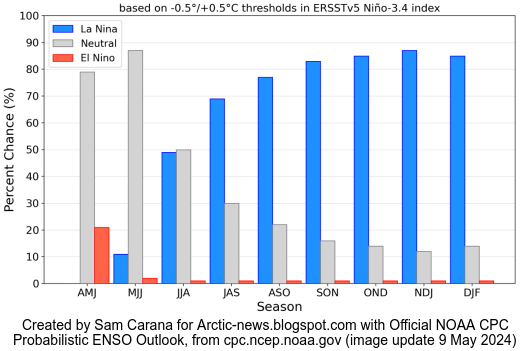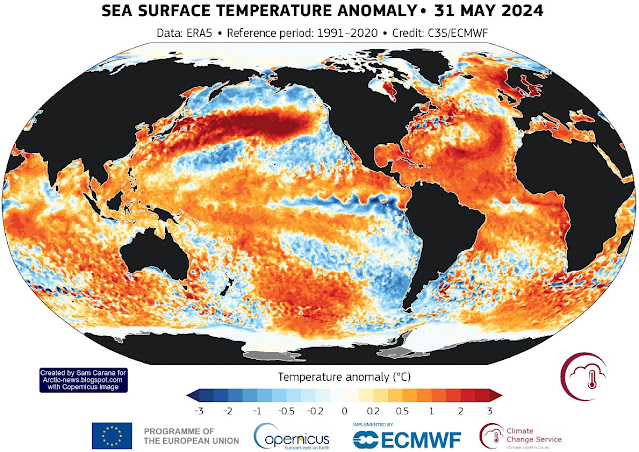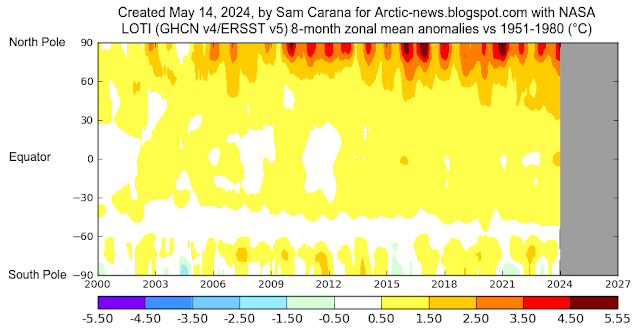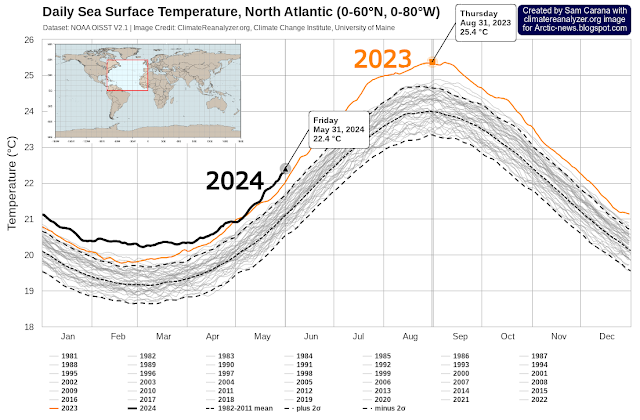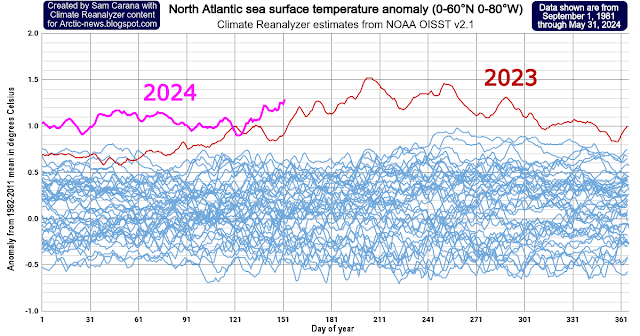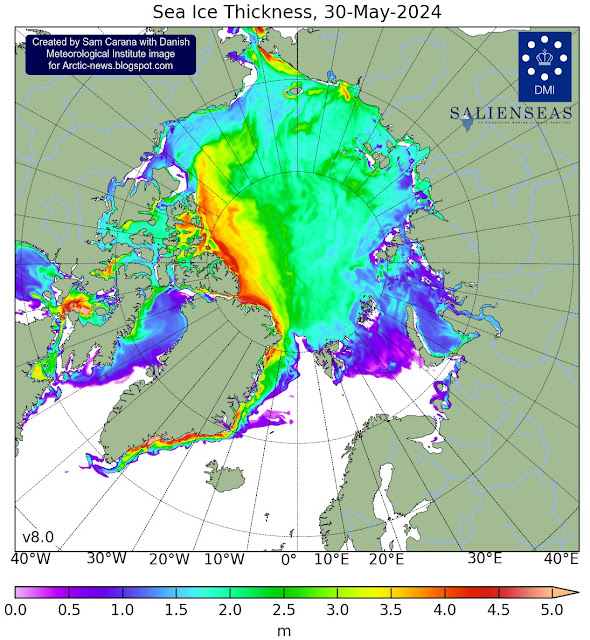The April 2024 temperature was 1.32°C higher than 1951-1980, as illustrated by the above image, created with NASA content. Local anomalies are as high as 6.2°C.
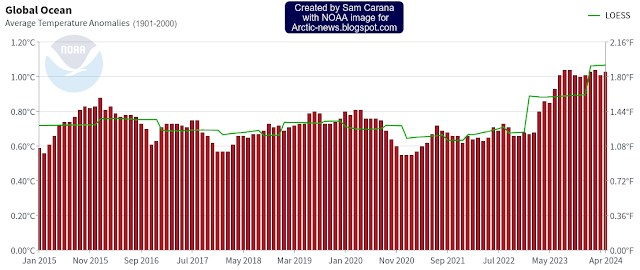 |
| [ click on images to enlarge ] |
 |
| [ from earlier post ] |
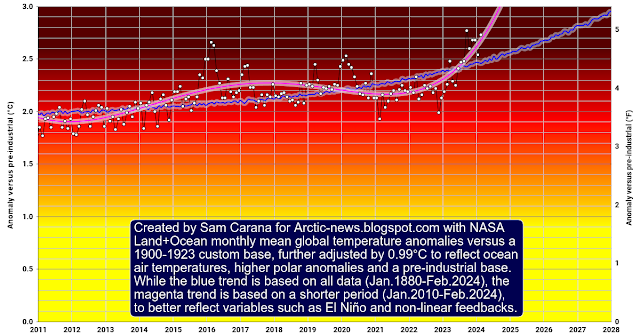 |
| [ from earlier post ] |
The above image shows a magenta trend that points at the temperature crossing 3°C above pre-industrial later this year (2024). What could be behind such a steep rise?
 |
| [ click on images to enlarge ] |
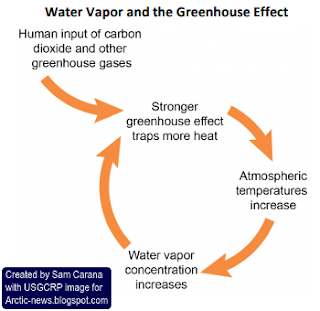 |
| [ from Moistening Atmosphere ] |
Furthermore, developments such as rising emissions from industry, transport, land use, forest fires and waste fires, ocean acidification and reductions in sulfur emissions over the past few years all contribute to further acceleration of the temperature rise.
Contributing to these high temperatures in the Arctic are high temperatures of the North Atlantic Ocean, which are now rising rapidly, in line with seasonal changes, as illustrated by the image below, created with Climate Reanalyzer content.
North Atlantic sea surface temperatures are now rising strongly, in line with seasonal changes. Ominously, a peak of 25.4°C was reached in August 2023. The question is how high the North Atlantic temperature will be in 2024 at that time of year.
The image below shows North Atlantic sea surface temperature anomalies versus 1982-2011. Data shown are from September 1, 1981, through May 31, 2024.
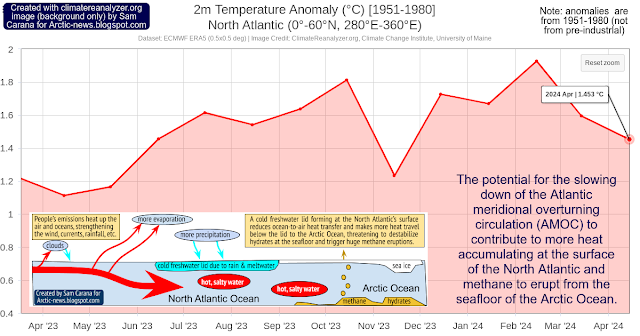 |
| [ click on images to enlarge ] |
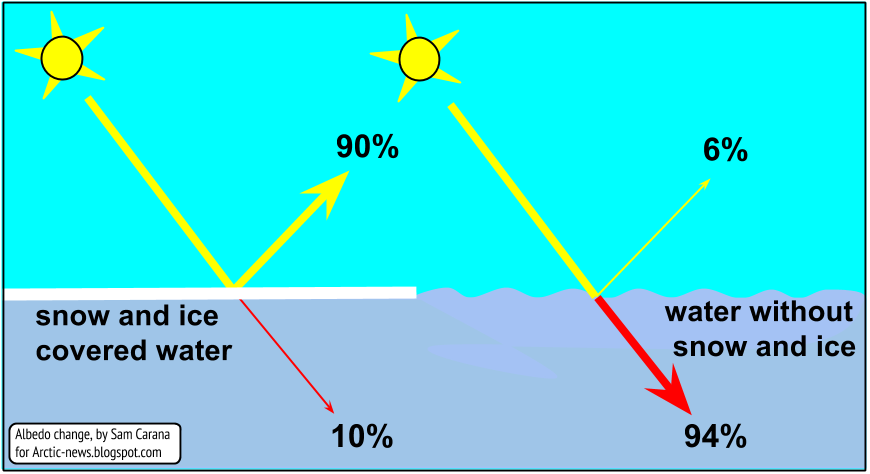 |
| [ Albedo change, from the Albedo page ] |
Next to the albedo loss, there is loss of the latent heat buffer constituted by the sea ice. Latent heat is energy associated with a phase change, in this case the energy consumed as solid ice turns into liquid water (i.e. melts). During a phase change, the temperature remains constant. Sea ice acts as a buffer that absorbs heat, while keeping the temperature at about zero degrees Celsius. As long as there is sea ice in the water, this sea ice will keep absorbing heat, so the temperature doesn’t rise at the sea surface.
As long as air temperatures over the Arctic are below freezing, sea ice can persist at the surface, maintaining sea ice extent, which may give the false impression that sea ice was healthy, whereas in fact sea ice has steadily been declining in thickness.
Arctic sea ice volume is at its lowest on record for the time of year, as illustrated by the image below, created with Danish Meteorological Institute content, and as also discussed in earlier posts such as this one.
Seafloor methane constitutes a second tipping point. When methane escapes from hydrates that get destabilized by rising temperatures, the methane will expand to 160 times its previous volume and enter the atmosphere with force. Without the buffer constituted by thicker sea ice, an influx of ocean heat could cause large-scale destabilization of hydrates contained in sediments at the seafloor of the Arctic Ocean, resulting in eruptions of huge amounts of methane.
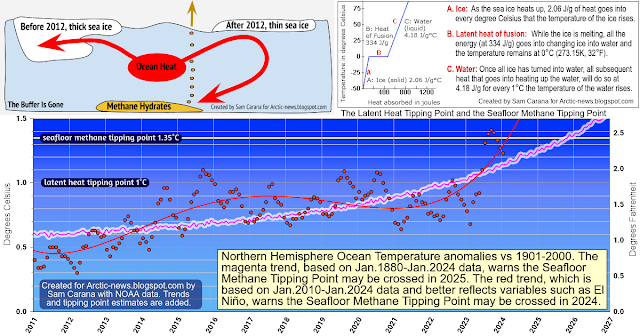 |
| [ from earlier post ] |
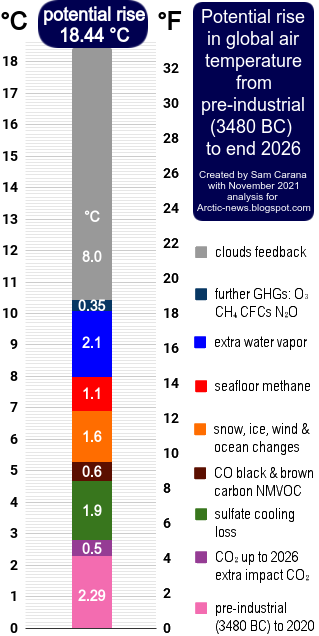 |
| [ image from the Extinction page ] |
Crossing of the latent heat tipping point and the seafloor methane tipping point results in ever more heat reaching and accumulating in the Arctic ocean, destabilizing methane hydrates contained in sediments at the seafloor of the Arctic Ocean, as discussed in many earlier posts such as this one.
Self-amplifying feedbacks and developments as discussed above, as well as crossing of these two tipping points, could all contribute to cause a temperature rise of over 10°C, in the process causing the clouds tipping point to get crossed that can push up the temperature rise by a further 8°C.
Altogether, the temperature rise may exceed 18°C from pre-industrial by as early as 2026, as illustrated by the image on the right, from the extinction page.
Links
• NASA – datasets and images
https://data.giss.nasa.gov
https://climatereanalyzer.org
https://pulse.climate.copernicus.eu
• NOAA – National Centers for Environment Information
https://www.ncei.noaa.gov
• NOAA – Climate Prediction Center / National Centers for Environmental Prediction
https://www.cpc.ncep.noaa.gov
• Pre-industrial
https://arctic-news.blogspot.com/p/pre-industrial.html
• Extinction
https://arctic-news.blogspot.com/p/extinction.html
https://arctic-news.blogspot.com/p/jet-stream.html
• Atlantic ocean heat threatens to unleash methane eruptions
https://arctic-news.blogspot.com/2024/03/atlantic-ocean-heat-threatens-to-unleash-methane-eruptions.html
• Danish Meteorological Institute – Arctic sea ice thickness and volume
https://ocean.dmi.dk/arctic/icethickness/thk.uk.php
• Cold freshwater lid on North Atlantic
https://arctic-news.blogspot.com/p/cold-freshwater-lid-on-north-atlantic.html
https://arctic-news.blogspot.com/2017/01/arctic-ocean-feedbacks.html
• Arctic sea ice set for steep decline
https://arctic-news.blogspot.com/2024/03/arctic-sea-ice-set-for-steep-decline.html
• Did the climate experience a Regime Change in 2023?
• Arctic sea ice under threat
• Transforming Society
https://arctic-news.blogspot.com/2022/10/transforming-society.html
• Climate Plan
https://arctic-news.blogspot.com/p/climateplan.html
• Climate Emergency Declaration
https://arctic-news.blogspot.com/p/climate-emergency-declaration.html

